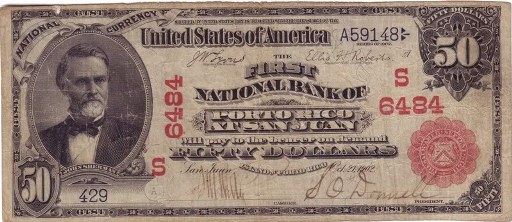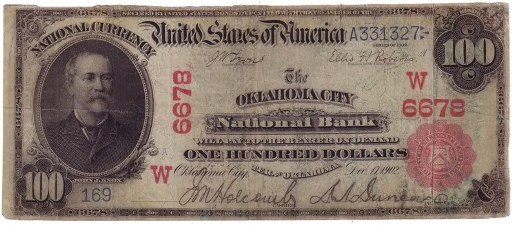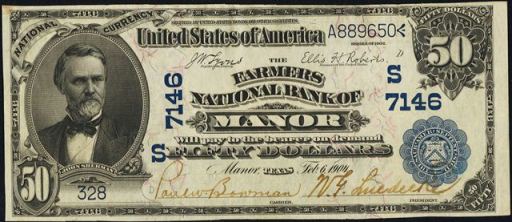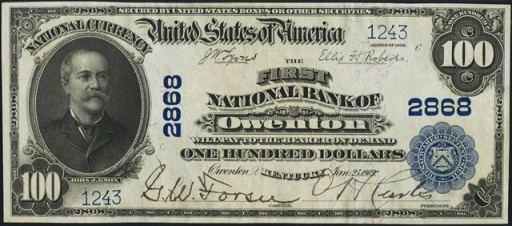The First National Bank Of Verden
The First National Bank Of Verden in Oklahoma printed $33,250 dollars worth of national currency. In the scheme of things, that is a very tiny output. Notes from this bank should be rare. This national bank opened in 1907 and stopped printing money in 1919, which equals a 13 year printing period. That is actually quite brief in terms of bank existence. During its life, The First National Bank Of Verden issued 4 different types and denominations of national currency. We have examples of the types listed below. Your bank note should look similar. Just the bank name will be different. For the record, The First National Bank Of Verden was located in Grady County. It was assigned charter number 8759.
We buy all national currency. Please call or email us for a quote. Sales@AntiqueMoney.com
The First National Bank Of Verden in Oklahoma issued 80 sheets of $50 1902 territorial red seal national bank notes. That is a remarkably small number. Any note known to exist from a print run like that would be a true statistical miracle of survival. We often talk about how rare 1902 $50 red seals are. However, that rarity gets lifted to a whole different level when we start talking about $50 territorial red seals. Only two are currently known to exist and they are both from San Juan, Puerto Rico. In fact, only six banks in the entire country issued the type (the other five issuers are all from Oklahoma).
1902 $50 Red Seal Territorial National Bank Note
The First National Bank Of Verden printed 80 sheets of $100 1902 territorial red seal national bank notes. There was a single $100 bill and $50 bill on each sheet of national bank notes of this type. There are currently only three 1902 territorial $100 red seals known to exist and one of those is in a museum. That total is spread across the entire country. So needless to say, these are rare birds indeed. Just like with the fifties, only six banks even printed $100 red seals as territorials. Obviously $100 was a lot of money back when these were printed (between 1902 and 1908). This is not something that was saved as a curiosity item. The ones that are known to exist were almost certainly saved by accident and rediscovered at a time when they had become collectible. At the time these were originally circulating no one knew these would one day become great rarities.
1902 $100 Red Seal Territorial National Bank Note
The First National Bank Of Verden also printed 120 sheets of $50 1902 blue seal national bank notes. There is no trick to knowing which 1902 blue seals will be common and rare. Often times the number printed won’t tell you much information. The value still comes down to condition and demand. That is a surprise to most people. In fact, most 1902 $50 bills we see are worth between $750 and $1,250. The rarer ones can be worth more than $5,000. However, there isn’t much middle ground.
1902 $50 Blue Seal National Bank Note
The First National Bank Of Verden also printed 120 sheets of $100 1902 blue seal national bank notes. It is no coincidence that the sheet numbers for $50 bills and $100 bills are the same. They were printed on the same sheets. Most $100 blue seals are at least scarce; others can be very rare. John J Knox is printed on the front of each bill. Most collectors like the back design a lot more though. It is really unique and different from most other national bank notes. Prices for 1902 $100 blue seals are pretty similar to $50 blue seals. They are both equally common or equally rare, depending on how you look at it.
1902 $100 Blue Seal National Bank Note



